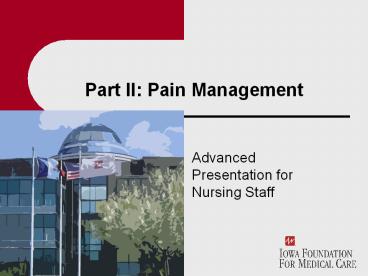Part II: Pain Management - PowerPoint PPT Presentation
1 / 26
Title:
Part II: Pain Management
Description:
Hydrocodone. World Health Organization Analgesic Ladder, cont. Step 3 - Severe Pain ... liver enzyme: codeine and hydrocodone cannot be metabolized and ... – PowerPoint PPT presentation
Number of Views:238
Avg rating:3.0/5.0
Title: Part II: Pain Management
1
Part II Pain Management
- Advanced Presentation for Nursing Staff
2
Complete Pain Evaluation
- Pain identified upon screening
- Complete a comprehensive pain evaluation
- Elements of a complete evaluation
- Location
- Intensity or severity
- Quality (description)
- Duration
- Pattern
- Current treatment/response
3
Key Steps for Comprehensive Evaluation
- Review screening tool
- Establish a protocol
- Monitor completion of tool
- Implement Care Plan
- Communicate
- Involve Interdisciplinary Team
4
Evaluating Pain in Mild to Moderately Cognitive
Impairment
- ASSESS!- Use standard scale
- Ensure understanding of tool (staff resident)
- Provide time to grasp tool, response and
repetition - Ask resident about present pain
- Observe for verbal/nonverbal pain-related
behaviors - Observe for changes in usual activities and
functions
5
Monitoring Treatment Effectiveness
- Pain scales
- Use appropriate tool considering physical and
cognitive status of resident - Use the same pain scale
- When
- Each shift
- Medication changes
- Change in condition
6
Key Steps in Monitoring
- Residents monitored for pain at least daily
- Pain scale used
- Responsibility for monitoring designated
- Results of monitoring recorded in medical record
- Re-evaluate plan of care based on monitored
results
7
Non-Pharmacologic Treatments
- Exercise
- Immobilization
- Transcutaneous Electrical Nerve Stimulation
- Acupuncture
- Cutaneous Stimulation
8
Non-Pharmacologic Treatments, cont.
- Relaxation and Imagery
- Distraction and reframing
- Psychotherapy
- Hypnosis
- Peer support groups
- Pastoral counseling
9
McGill Pain QuestionnaireExample of Verbal
Analog Scale
- 0- No pain
- 1- Mild
- 2- Discomforting
- 3- Distressing
- 4- Horrible
- 5- Excruciating
10
World Health Organization Analgesic Ladder
- Step 1- Mild Pain
- Non-opioid
- Acetaminophen
- NSAID
- Step 2- Moderate Pain
- Mild opioid
- Acetaminophen with codeine
- Hydrocodone
11
World Health Organization Analgesic Ladder, cont.
- Step 3 - Severe Pain
- Strong opioid
- Morphine
- Duragesic
- Long-acting
- Note Residents on strong opioids should be
started on prophylactic regimes to prevent
constipation - Refer to REFERENCE INFORMATION for opioid
equivalency
12
Reassess
- When
- Regular intervals
- Complaints of increasing pain
- Elements of reassessment
- All elements of comprehensive assessment
- Who
- Anyone requiring an increase in frequency of prn
medication
13
Opioids
- Safe effective analgesics
- Oral route equally effective as injectable
- No ceiling effect
- 7-10 population lack CYP2D liver enzyme codeine
and hydrocodone cannot be metabolized and
therefore will not be effective
14
Physician Barriers to Effective Opioid Pain
Control
- Fear of causing addiction or relapse
- Fear of regulatory and legal barriers
- Lack of experience with opioid analgesics
- Side effects
15
Patient Barriers to Effective Opioid Pain Control
- Patient and family fear of addiction
- Misconception about side effects
- Reluctance to report pain
- Physician patient relationship
16
Addiction
- Rare in patients given opioids for pain
- Less than 1
- 11,882 patients/ 0 addiction
- Porter and Jick, NEJM 302 123, 1980
17
Regulatory Concerns
- State and Federal regulatory concerns over
exaggerated - Documentation and record keeping is key
- History and Physical
- Treatment plan
- Reassessment
18
Medications to Avoid in the Elderly
- Meperidine normedperidine that lowers seizure
threshold and increases delirium - Propoxyphene (Darvon) poor analgesic
- Pentazocine (Talwin) poor analgesic, frequently
causes delirium and agitation
19
Key Steps to Improving Treatment
- Step 1
- Administer medications routinely, not prn
- Step 2
- Use the least invasive route of administration
first - Step 3
- Begin with low dose-titrate up
20
Key Steps to ImprovingTreatment, cont.
- Step 4
- Monitor and document effectiveness of medication
daily - Step 5
- Reassess and adjust dose to optimize pain relief
while monitoring and managing side effects
21
Quality Improvement Steps
- Step 1
- Document current practice
- Step 2
- Evaluate and identify areas to improve
- Step 3
- Select one area to improve 1st
- Step 4
- Define current process
22
Quality Improvement Steps
- Step 5
- Make changes
- Step 6
- Pilot test changes
- Step 7
- Evaluate changes
23
Improving the Quality Measure
- Improve
- MDS coding
- Pain assessment
- Pain management program
- Implement
- QA/QI team based on internal need
- Include pharmacy consultant
- Medical director
24
Care Planning Components
- Pharmacologic component
- Non-pharmacologic component
- Monitoring component
25
Key Steps in Care Planning
- Gather assessment data
- Set realistic goals
- Implement interventions
- Involve residents and staff
- Revisit care plan for effectiveness
26
Summary
- All the steps are essential for effective pain
assessment and management - Achieving improved pain control in the elderly
- Team approach
- Individualization of plan of care
- Start low and go slow
- Combined treatments
- This material was prepared by the Iowa Foundation
for Medical Care, the Medicare Quality
Improvement Organization for Iowa, under contract
for the Centers for Medicare Medicaid Services
(CMS), an agency of the U.S. Department of Health
and Human Services. The contents presented do
not necessarily reflect CMS policy. - 8SoW-IA-PPT-NH-5/07-028































